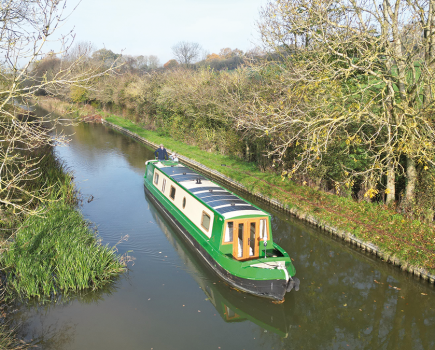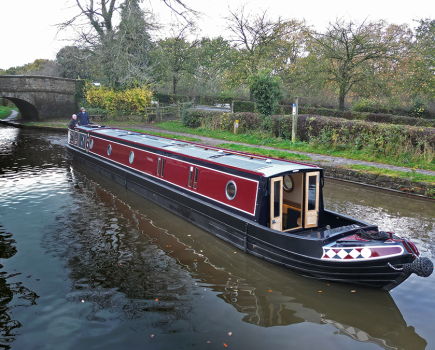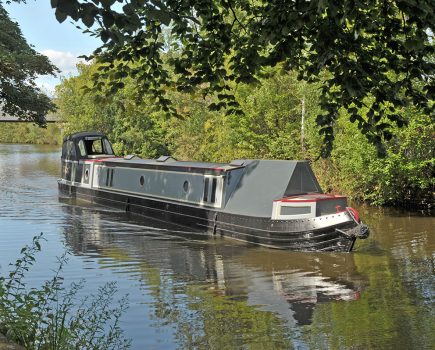With hydraulic drive and well thought-through design and style, it’s little wonder this boat was runner up at Crick

Fortunately, in boating as in the rest of life, different people like different things. It’s just as well, because otherwise all boats would be the same. But it’s still surprising how varied people’s preferences can be. For example, while some people dream of having a boat powered by a vintage engine, Nigel Halladay can’t imagine anything worse. In fact, when he and his wife, Lauraine, had their own boat built, peace and quiet for the helmsman was his prime requirement.
The reason was that his parents had a boat with a Gardner 2LW – one of the classic old thumpers of the waterways – and he didn’t get on with it. “It gave me headaches, a face full of exhaust dust, and it used to vibrate the whole boat,” he says. “Even if I won a vintage engine, I wouldn’t put it in my boat!”
The solution to keeping things quiet was a modern engine, and not under your feet as normal, but in an engine room away from the helm. And rather than a propshaft running under the floor, there would be hydraulic drive. This decision to go hydraulic was influenced by Nigel’s other main requirement: a bow thruster that would be always available.
But the hydraulic drive probably isn’t the reason why this boat scored very well in the public vote for Favourite Boat at the Crick Show and came second. The reason is much more likely to be the style of the interior, the appealing back cabin and the high quality fit-out.

EXTERIOR
This 70-footer is built on a Colecraft shell, a decision that’s unusual for builder Braidbar Boats. Nigel’s parents’ boats had been Colecrafts, so he was keen to have another. He likes the lines with a distinct lift in the cabin at the stern, and more lift in the back counter – just look at the depth of those tunnel bands.
The bow isn’t the normal Colecraft one, though, which tends to look quite short. He wanted something a bit curvier, a bit more Josher-inspired. The result is Colecraft’s first attempt at a Josher-style bow. It looks nice and certainly suits a long boat like this, but they could perhaps have gone even curvier, and a more substantial stem post would also have helped give more impact.
The steelwork is undoubtedly of good quality, though. The handrails have finger grips and scrolls in the ends. The traditional look is emphasised by side doors to the engine room and a pigeon box in the roof. Less traditional are aerials for the three DAB radios on board, and a 4G Wi-Fi internet receiver (which does at least fold down when travelling).
There are two Houdini hatches, which are anodised rather than brass, to match the double-glazed windows by Channelglaze. The windows themselves are deeper than normal at 24 inches rather than 21, to let in extra light.
There are two stoves on board, so there are two chimneys with substantial collars by Warstock. Peter Mason from Braidbar Boats is somewhat obsessive about making sure the chimneys rise vertically from the roof rather than at an angle; it apparently took a long time to get the back cabin chimney collar to sit correctly, given the sweeping curves of the roof at that point.
The gas locker is in the bow, while the water tank is integral to the boat under the well deck. Also down here is the hydraulic bow thruster. On the well deck itself there’s a wooden storage box, that also provides somewhere to sit.
The maroon colour scheme is very attractive. The panels have a cream coach line and black borders, while the handrails are a brighter red and the roof a raddle red. We were impressed by the quality of paintwork, which is done in house at Braidbar. The sign-writing and decoration is by Andy Russell, who’s proved yet again that he’s one of the best at his trade. The name panel on one side includes a Cornish shield (the first hint of the owners’ Cornish home), while the stern door panels have Cornish engine houses rather than traditional castles.

LAYOUT AND FIT-OUT
This is a boat with a traditional layout, including a back cabin. Forward of this comes the engine room which doubles as a utility. The cabin is next, followed by a walk-through shower room and the dinette. Then comes the galley, with the saloon at the bow.
The fit-out uses ash tongue and groove above the gunwales with oak panels below. The trim is oak and the floor a very attractive burnt and oiled oak; it’s a choice that has become very popular among Braidbar customers.
BACK CABIN
At first glance this looks like a very traditional back cabin, but take a closer look and you find it’s been adapted to suit the owners’ needs. For a start, it’s a bit shorter than normal, and because there’s no propshaft running under the floor, there’s also full head height.
And while the layout is pretty standard, with a bench seat down one side and a stove and cupboards on the other, all is not quite what it seems here, either. What would normally be the bedhole, for example, actually contains the hydraulic reservoir. It means there’s no cross double bed so the bench seat has a pull-out extension, making it into a decent-sized single bed.
There are many traditional elements, though, including the Epping stove. There’s a brass kimball lamp, which has a 12-volt bulb (the only light in the whole boat not to be an LED) and Lauraine has dressed the cabin nicely with drapes and cushions. Andy Russell deserves another mention for his scumbling work and more superbly painted Cornish engine houses, which were one of the talking points among the crowds at Crick. If it’s not quite cold enough to light the stove, there’s a Matrix fan heater in the back steps that’s run from the Eberspächer boiler.

ENGINE ROOM
You could almost walk through this room without realising there’s an engine here because it’s boxed in and offset to one side. A taller unit alongside houses one of the biggest hospital silencers you’re ever likely to have seen on a boat.
On the other side there’s a range of cupboards. One houses the washer-drier, while another has the batteries in the base. They’re low maintenance ones, so access isn’t needed everyday, but when they do eventually need to be changed, the shelf above flips up so they can be lifted out. A high level cupboard contains the inverter, while all the gauges and controls are on the outside.
All the cupboards throughout the boat have soft-close doors, and the doors between the rooms have cushioned stops. The pigeon box even has a sliding wooden cover.
CABIN
The bed is inline and extends. Above its head there’s a high level cupboard with reading lights and a radio housed in the base so it’s immediately above you in bed. The control for the central heating is also readily to hand on the end of the unit. There’s a substantial wardrobe with shelves, drawers and hanging space. On the other side, a corner unit has a mirror above.

SHOWER ROOM
The quadrant shower is a generous 900 by 760mm and is lined with attractive laminate. There are two shower heads, one overhead and one handheld. There are airing cupboards between the shower and the cabin sides, with the calorifier in the lower one. There are also two large curved towel rails, one either side of the room.
The loo is a macerating unit by SaniMarine, with the holding tank immediately behind, under the bed. The basin is set on a corner unit with a large mirror illuminated from above by hidden LED lights. There are more LED lights under the gunwales which light up red and are designed to be used if you have to get up in the night: there’s enough light to see by, but not enough to wake up anyone else.
DINETTE
The raised dinette is a Braidbar staple, and includes their wider-than-usual table. The whole thing converts into a double bed and there’s storage in the bench seats. Above the dinette, a high level unit contains the Wi-Fi router in the centre. Attractive wall lights in keeping with the décor have been converted to operate on pull cords, to avoid the need for too many wall switches.

GALLEY
One of Braidbar’s trademark C-shaped bulkheads divides the dinette from the galley. On the other side of the boat, a set of side doors have a flip-over hatch and make a proper access point thanks to a set of steps which are stored under the gunwales when not in use. The door panels have more lovely images of Cornish engines. On the same side there’s a Welsh dresser with cupboards, drawers and high level storage. The units opposite are topped with dark granite with a recessed drainer for the stainless steel sink. As well as a normal tap, there’s drinking water from a Seagull filter. The cooker is a full-size Belling with an extractor unit above routed to a mushroom vent on the roof. Alongside the cooker there’s a slim cupboard to make the most of every inch of space. Nigel was keen to have some separation between the galley and the saloon, so designed a couple of pillars to form a bulkhead.
SALOON
On one side of the saloon there’s a Morso solid fuel stove, but it’s not the Squirrel stove seen so often; it’s a much more contemporary design and looks great. The surround has striking copper-coloured mosaic tiles in another nod towards Cornwall. On the opposite side there’s a second set of side doors, but this one has permanent steps, set on a rather nice curve. Usefully, there’s storage in the bottom one.
A long unit under the gunwales on one side of the saloon houses an Autex 12-volt TV, a DAB radio and large speakers which have been turned into something of a feature rather than trying to hide them. The bow doors are glazed full length, in another effort to let as much light into the boat as possible. There are units either side of the doors with glazed and illuminated high level cupboards above. These have acrylic shelves with laser-cut slots to hold glasses which makes them appear to be floating in mid air. LED lights under the gunwales can be set to different colours.
TECHNICAL
Integrity is powered by a Beta 50, with two hydraulic pumps on one end. One is linked to the hydraulic pod at the stern which turns the prop. The second smaller pump is for the bow thruster, which has two props. The other addition to the engine is a cooling tank for the hydraulic oil. The whole hydraulic system comes from ARS.
Access to the engine could hardly be better. The lid lifts and is kept up by a brass catch, then the side panel lifts out revealing the bits you need to get to on a regular basis, such as the oil and air filters. Servicing will be much easier than an engine in a modern trad or even a cruiser stern with no need to lean over the engine, or reach round it.
Electrical power comes from two 220Ah sealed AGM batteries, plus a starter battery. The inverter is a 2.5kW Mastervolt unit, but the boat has been equipped with mostly 12-volt appliances so it won’t be needed very often, only really for the washer-dryer. A Nereus detector system is fitted, with two LPG sensors and one for carbon monoxide. Heating is from an Eberspächer diesel boiler.
ON THE WATER
It seems counter-intuitive to have a modern hydraulic drive and traditional brass controls, but they work very well together. There’s a pushrod to select forward or reverse, and govern the proportion of power going to the hydraulic pod. This means the prop can be set to turn very slowly, by only just engaging gear; only when the pod is at full power do you need to use the speed wheel to increase engine revs.
This proportional aspect is particularly noticeable when using the bow thruster, which is operated by a little lever tucked out of sight to one side of the rear hatch. While electric bow thrusters are either on or off, this one can operate at any speed you like – simply push the lever a little or a lot. And you can just leave it going for as long as you like; you don’t even need to keep your finger on the lever.
Some engine-driven hydraulic systems we’ve tried in the past had something of a delay, but this one didn’t. It’s certainly quieter than having an engine directly under your feet, but there is still some noise from the hydraulic pod. Nigel is hopeful that some tweaks to the system will make it even quieter. The bow prop is very quiet, though, without any of the tell-tale whine you get from an electric system. The boat handles extremely well, responding smartly and precisely to the tiller. With a long boat such as this, the bow thruster makes manoeuvring in confined spaces much easier.
CONCLUSION
There’s an awful lot to like about this boat, from the classy exterior colour scheme to the high quality fit-out. The Cornish touches add a spark of individuality which is also very appealing.
It’s also well equipped which, of course, pushes up the price. It came in at around £180,000, but Braidbar’s Peter Mason says around £15,000 of that is for the hydraulic system alone, while a back cabin is also a lot more work than a standard build. A more conventional Braidbar 70-footer would be around £150,000 and a 57ft boat would cost around £110,000. So a Braidbar doesn’t have to be expensive, it just depends on what extras you want.
The boat works well and bears all the hallmarks of owners who knew what they wanted and how to make it work.
They’ve skilfully mixed traditional elements and modern technology. And while it’s obviously to their own design and taste, the boat’s success at Crick shows that good design and execution will always have a wide appeal.
Integrity – circa £180,000
Length: 70ft
Style: Trad
Berths: 4
Layout: Standard
Power: Beta 50
Image(s) provided by:
Archant







